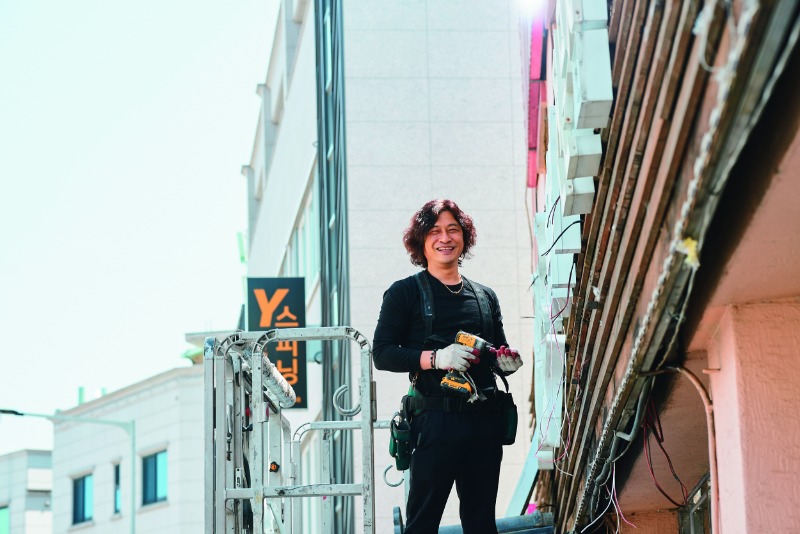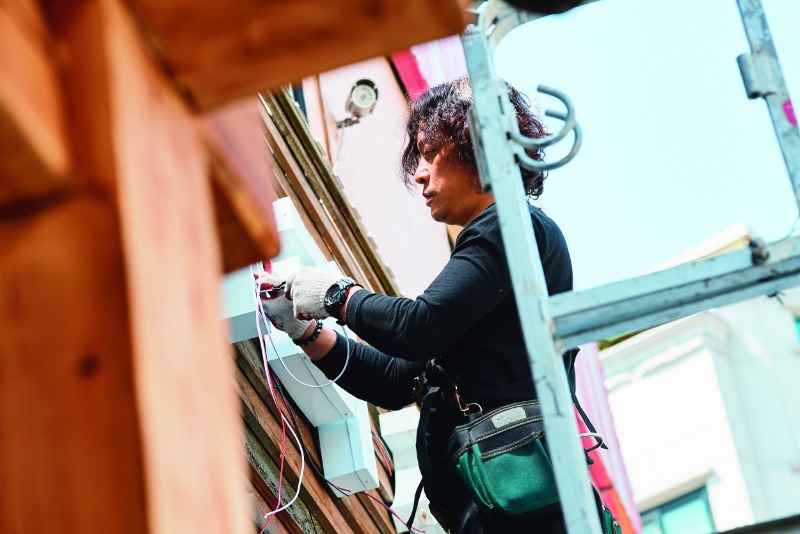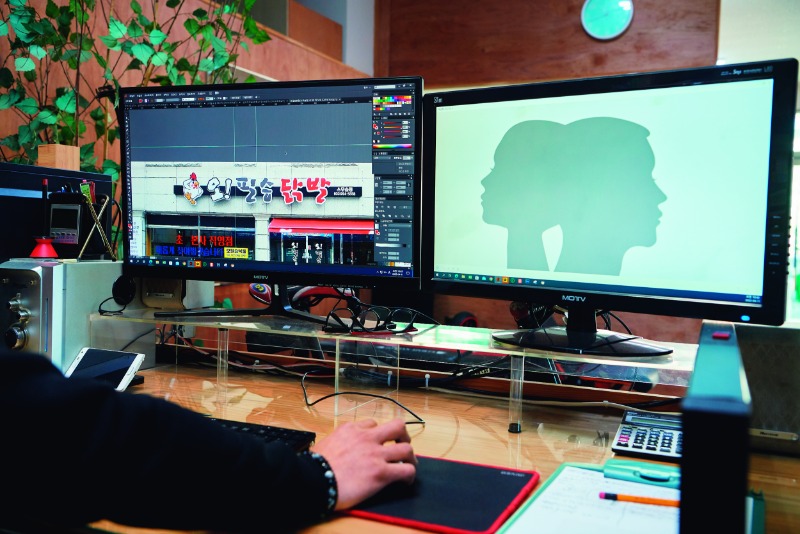Need a sign made? Visit the highly reputable DISIGN M at the foot of Mt. Daeryong overlooking Chuncheon, the capital of Gangwon Province. There, you will meet CEO Park Geun-chul, and no one else. He is both employer and employee, keeping pace with steady demand.

Park Geun-chul’s company DISIGN M has been producing storefront signage since 2005. Along the way, Park has become an expert at understanding the nuances of clients’ requests.
Strolling through an unfamiliar neighborhood of restaurants, would-be diners are apt to pick a place with an eye-catching sign. Without appealing signage, the best food, service and atmosphere could go unnoticed. It’s the key to convincing customers to open the door. And Park Geun-chul is a master locksmith.
The “DISIGN M” sign at the entryway to Park’s workplace is simple but bold. Stepping inside to a tidy, wellkept office, the stillness is arresting. There is simply no trace of human activity in a space that could easily accommodate ten workers.
Then Park appears, rising from between two monitors. He can be so focused on a new design that he scarcely notices any visitors. Behind him is a bookcase crammed with journals and tidy notebooks. They match the number of signage projects he has tackled over the years. Each notebook narrates the work, from the client’s initial requests to the record of the final payments. Flipping through the pages is like retracing Park’s footprints each year.
First Sign
In 1997, the Asian Financial Crisis crippled Park’s family and he had to suspend his architectural engineering studies at Kyungdong University in Gangwon Province, on the other side of Hangyeryeong Pass, where he grew up in the town of Injae.
Park considered being a career solider and applied to become a non-commissioned officer. But dire economic conditions across Korea meant stiff competition. In the end, he used the time off to fulfill his mandatory military service and then went to work to save money for tuition. After a spate of job-hopping, he ended up at a company in Chuncheon that manufactured signage. There, he learned sign design, production and construction.
The first sign designed by Park was for a restaurant that served chicken feet. Today, the same sign is peppered all across Chuncheon, the capital of Gangwon Province; the original restaurant flourished into a chain with some 20 franchises around the region. “Looking back now, the font, the images – it all feels a bit tacky. But I’m proud to still be producing new versions of my first-ever design, 20 years later,” Park says.
At the time, Park’s monthly pay of 850,000 to 900,000 won was enough for rent and food but not for his college tuition as well. Of course, even with a degree, there was no guarantee of a secure future. So Park decided the smarter route might be to forget about school and fully master the skills he was learning at the signage manufacturer so that he could set up shop for himself.
The signage business demands many skills. The creation of just one small sign requires aptitude in ironwork, lighting and even electricity. Welding, grinding and drill work are all de rigueur, as is mastery of cutting, electrical wiring and working with various specific raw materials.
Park started his company in 2005, equipped only with a journal full of information gleaned from design books and by peeking over the shoulders of co-workers. The beginning was rough. There were few projects available and hometown connections were usually the deciding factor. But today, thanks to his sterling reputation, Park no longer needs a sales agent. He has whittled down his personnel needs to just himself.
Working with Intuition
Park possesses an intuition that supplants logic, knowledge and reason, and this is displayed in his designs. Drawing on his years of experience, he is quick to grasp a client’s vision and produce a design concept that fits. The same goes for the name of his company: “M.” He didn’t spend any time pondering deeper meanings or references. Just as he was wondering, “What should I name my company?” he happened to notice a brand logo printed on a credit card. “Ah, that’s it!” he thought. It was the letter M.
When Park receives a request from a client, he begins by visiting the site in question. The basic principle in designing a sign, he says, is meticulously recording the customer’s needs and desires and adhering to them. Thus, the overflowing notebooks.
A typical workday begins at 8 a.m. and ends at 6 p.m. In the solitude of being the CEO and only designer, he begins projects by envisioning a sign that suits its surroundings. He mulls over which points to emphasize to make it stand out. Something classy that draws the eye without being obtrusive – that’s the kind of design he’s after.
Occasionally, his designs are rejected. In these cases, Park never insists. Instead, he quickly absorbs the client’s feedback and immediately returns to his drawing board. As a designer, he has an open mind. This and his intuition are his company’s most valuable assets, ensuring its continued success.
From time to time, Park will receive a sad order. Banners that read “For Rent,” for example, for clients forced to shut down their business. Out of empathy, he refuses payment for these orders. He simply puts up the sign and leaves.

Sign work requires proficiency in working with metal, lights and electricity. With all the wiring and ladders involved, a certain amount of risk comes with some orders, making safety precautions a must.
Hazards
Park doesn’t spend all day hunched over new designs. He also gets involved in the installation of his creations. At the worksite of a new client, a restaurant specializing in spicy octopus, Park straps on a heavy toolbelt and mounts a hydraulic lift without hesitation. As he finishes wiring the sign, putting the cap back onto each letter, a heavy drop of sweat rolls down his forehead and falls to the ground.
This installation phase was much more dangerous when Park first started in the sign business. At the time, even huge signs that weighed hundreds of kilograms had to be hoisted by manpower alone, using complex systems of ropes to suspend the technicians themselves during installation.
“It was all so scary back then. We didn’t have equipment like we do now – there were no ladder cars or anything. We’d just pull the sign up onto the roof of a four- or five-story building, and then rely on simple scaffolding to support us through the installation. Just thinking about it now, I still feel dizzy.”
On average, each person would be responsible for pulling about 100 kilos of weight. Accidents occurred from time to time. One mishap involved eight people on a roof pulling up a sign that was 30 meters long, while one person on a ladder pushed it up from below. The man on the ladder suddenly fell from a height of three stories.
“The latch in the extension ladder had come undone and he slipped. The guy had just gotten married too, not long before… To this day, he still uses a cane,” Park says.
Park raises his left thumb. “I can’t bend my thumb. Severed a ligament while working with a drill,” he explains. On his middle finger, too, an obvious scar marks the spot where his glove, sucked into a drill mechanism, left another wound.

The first sign Park ever designed himself, two full decades ago, was for a restaurant that sold chicken feet. The restaurant become a wildly successful franchise business, and copies of the sign hang over more than twenty locations in Chuncheon alone. Whenever another new location is ready, Park is called.
Soloing Smoothly
Park’s signs themselves do the job of marketing DISIGN M, showcasing his decades of design and construction in Chuncheon. They appear at a wide range of places, including restaurants, office buildings and schools. The biggest sign was 30 meters long; an eight-person crew dangling on ropes was used to construct it.
Over the years, the technical aspects of signs have changed, as has the technology to make them. A common square sign is called a flex sign, made by printing on fabric and pulling at the four corners. Nowadays, signs that make letters using LED modules are popular.
Park is also in demand to design business cards and simple brochures, which further adds to his exposure in the advertising market. Indeed, his reputation is only strengthened by the deep trust he is able to forge with each client. And yet, Park is stumped when asked to explain how trust is established. Perhaps one factor in his case is that ruthless ambition is absent, unable to complicate his business relations.
Park has no big plans to grow his company or retire soon. He’s satisfied with being his own workforce and plans to continue as long as possible. He simply pledges to carry on as he founded his company, putting his all into diligently designing and carefully creating the best products that he can for his customers.